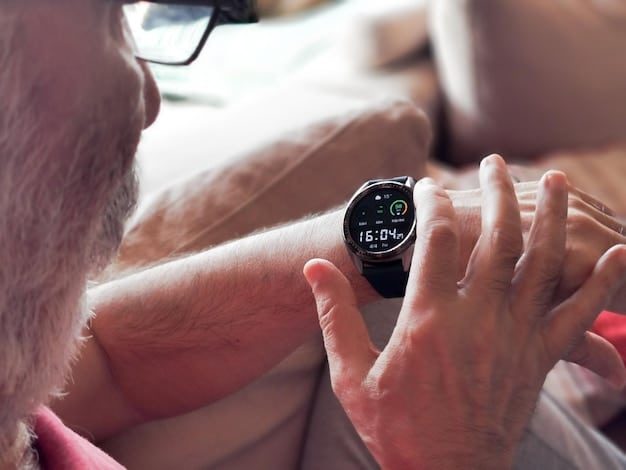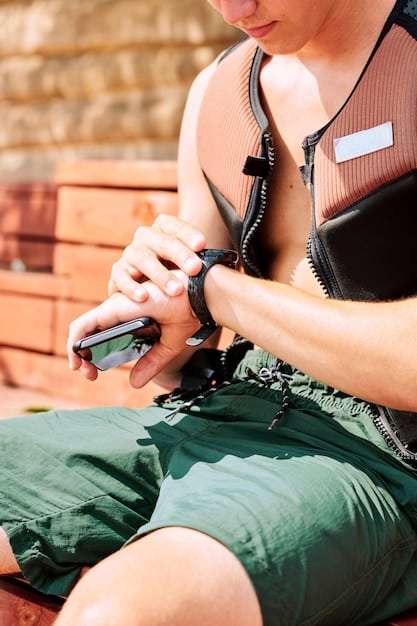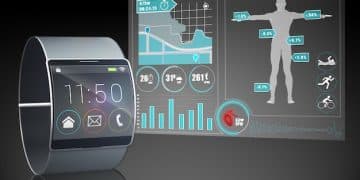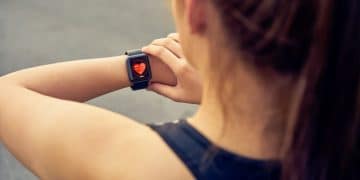The Latest Innovations in Wearable Health Tech: Real-Time Vital Signs Monitoring

The Latest Innovations in Wearable Health Tech are revolutionizing healthcare by providing real-time monitoring of vital signs, enabling proactive health management and personalized wellness solutions for users in the US, empowering individuals to take control of their health in unprecedented ways.
The world of healthcare is rapidly evolving, and at the forefront of this transformation are the latest innovations in wearable health tech: monitoring your vital signs in real-time. These devices are not just gadgets; they’re becoming essential tools for proactive health management.
The Rise of Wearable Health Technology
Wearable health technology has moved beyond simple fitness trackers to sophisticated devices capable of monitoring a wide array of vital signs. This evolution is driven by advancements in sensor technology, data analytics, and a growing consumer interest in personalized health management.
The Evolution of Wearables
From basic pedometers to advanced devices that track heart rate variability, sleep patterns, and even blood glucose levels, the capabilities of wearable health tech have expanded dramatically. This evolution reflects a deeper understanding of the human body and the potential for continuous monitoring to improve health outcomes.
Impact on Healthcare
The real-time data provided by these wearables can significantly impact healthcare. Doctors can use this information to gain a more comprehensive understanding of a patient’s health, leading to more accurate diagnoses and personalized treatment plans. Moreover, wearables empower individuals to take a more active role in managing their own health.

Here are some key areas where wearable health tech is making a significant difference:
- Preventive Care: By identifying potential health issues early, wearables can help prevent chronic diseases and improve overall well-being.
- Chronic Disease Management: Wearables can assist individuals with conditions like diabetes, heart disease, and asthma by providing continuous monitoring and alerts.
- Personalized Fitness: These devices offer tailored workout recommendations based on real-time biometric data, helping users achieve their fitness goals more effectively.
In conclusion, the rise of wearable health technology marks a pivotal shift in healthcare, offering individuals and medical professionals alike the opportunity to harness the power of real-time data for better health outcomes.
Key Vital Signs Monitored by Wearables
Wearable health devices can monitor a variety of vital signs, providing users with a comprehensive overview of their health status. Understanding what these devices track is crucial for making informed decisions about personal health management.
Heart Rate Monitoring
Continuous heart rate monitoring is a standard feature in most wearables. This data can be used to assess cardiovascular health, track fitness levels, and detect potential arrhythmias. Advanced devices also measure heart rate variability (HRV), which is an indicator of stress and overall well-being.
Sleep Tracking
Wearables can track sleep patterns, including the duration and stages of sleep (light, deep, REM). This information helps users understand their sleep quality and identify potential sleep disorders.

Blood Oxygen Saturation (SpO2)
Many newer wearables now include the ability to measure blood oxygen saturation (SpO2). This is particularly useful for individuals with respiratory conditions or those who want to monitor their oxygen levels during exercise or at high altitudes.
Here’s a breakdown of other vital signs that some advanced wearables can monitor:
- Body Temperature: Tracking changes in body temperature can help detect early signs of illness.
- Electrocardiogram (ECG): Some wearables can record an ECG, which can detect heart abnormalities like atrial fibrillation.
- Blood Glucose Levels: Continuous glucose monitoring (CGM) is becoming increasingly integrated into wearable devices for individuals with diabetes.
In summary, the array of vital signs monitored by wearables is expanding rapidly, providing users with a comprehensive and real-time view of their health.
Innovations in Sensor Technology
The advancements in wearable health tech are largely driven by innovations in sensor technology. These sensors are becoming smaller, more accurate, and more energy-efficient, allowing for continuous monitoring without sacrificing comfort or battery life.
Miniaturization of Sensors
One of the key trends in sensor technology is miniaturization. Smaller sensors can be integrated more seamlessly into wearable devices, making them less obtrusive and more comfortable to wear.
Improved Accuracy
Accuracy is paramount when it comes to monitoring vital signs. Researchers are constantly working to improve the accuracy of wearable sensors, using techniques like signal processing and calibration algorithms to minimize errors.
Energy Efficiency
Energy efficiency is crucial for extending the battery life of wearable devices. New sensor technologies are being developed to consume less power, allowing for continuous monitoring without frequent charging.
Consider these advancements in sensor technology:
- Photoplethysmography (PPG): This optical technique is used to measure heart rate and blood oxygen saturation by detecting changes in blood volume in the skin.
- Inertial Measurement Units (IMUs): These sensors measure motion and orientation, enabling activity tracking and fall detection.
- Electrochemical Sensors: These sensors can measure various biomarkers in sweat or interstitial fluid, providing insights into hydration levels, glucose levels, and more.
In conclusion, innovations in sensor technology are paving the way for more sophisticated and accurate wearable health devices, enabling continuous and comprehensive monitoring of vital signs.
Data Analytics and Personalized Insights
The vast amount of data generated by wearable health devices is only valuable if it can be analyzed and translated into meaningful insights. Advanced data analytics techniques are used to identify patterns, trends, and anomalies in the data, providing users with personalized recommendations for improving their health.
Machine Learning Algorithms
Machine learning algorithms play a crucial role in analyzing wearable health data. These algorithms can learn from large datasets to identify patterns that may not be apparent to the human eye, such as early signs of illness or risk factors for chronic diseases.
Personalized Recommendations
Based on the analysis of their data, users receive personalized recommendations for improving their health. These recommendations may include suggestions for exercise, diet, sleep, and stress management.
Predictive Analytics
Predictive analytics can be used to forecast future health outcomes based on current and historical data. This allows users to take proactive steps to prevent health problems before they arise.
Here are a few examples of how data analytics are used in wearable health tech:
- Sleep Analysis: Wearables can analyze sleep data to identify patterns and provide recommendations for improving sleep quality.
- Activity Tracking: Data analytics can be used to track activity levels and provide personalized workout recommendations.
- Stress Management: Wearables can monitor heart rate variability and other biometric data to detect stress and provide recommendations for relaxation techniques.
In summary, data analytics and personalized insights are essential components of wearable health tech, transforming raw data into actionable information that empowers users to take control of their health.
Challenges and Future Directions
Despite the remarkable advancements in wearable health tech, there are still challenges to overcome. Addressing these challenges will be crucial for realizing the full potential of these devices and ensuring that they are accessible and beneficial to everyone.
Data Privacy and Security
Data privacy and security are major concerns when it comes to wearable health tech. Users need to be confident that their data is protected from unauthorized access and misuse. Robust security measures and transparent data policies are essential for building trust.
Accuracy and Reliability
While the accuracy of wearable sensors has improved significantly, there is still room for improvement. Ensuring the reliability of these devices is crucial, particularly when they are used for medical purposes.
Accessibility and Affordability
Wearable health tech needs to be accessible and affordable to everyone, regardless of their socioeconomic status. Efforts are needed to reduce the cost of these devices and make them more widely available.
Here are some potential future directions for wearable health tech:
- Integration with Telemedicine: Wearables can be integrated with telemedicine platforms to provide remote monitoring and virtual consultations.
- Advanced Sensor Technologies: New sensor technologies will enable the monitoring of a wider range of biomarkers and vital signs.
- Personalized Medicine: Wearables will play a key role in personalized medicine, tailoring treatments to individual patients based on their unique biometric data.
In conclusion, while there are challenges to overcome, the future of wearable health tech is bright. Continuous innovation and a focus on addressing these challenges will pave the way for a new era of proactive and personalized healthcare.
The Role of Wearables in Remote Patient Monitoring
Remote patient monitoring (RPM) is transforming healthcare delivery, and wearable technology is a key enabler of this shift. By continuously tracking vital signs and other health metrics, wearables allow healthcare providers to monitor patients remotely, detect potential issues early, and intervene before they become serious.
Benefits of Remote Monitoring
Remote patient monitoring offers numerous benefits, including reduced hospital readmissions, improved patient outcomes, and lower healthcare costs. It is particularly beneficial for individuals with chronic conditions, such as heart disease, diabetes, and respiratory illnesses.
Wearables in RPM Programs
Wearable devices are increasingly being integrated into RPM programs. These devices can provide real-time data on heart rate, blood pressure, blood glucose levels, and other vital signs, allowing healthcare providers to track patients’ health status remotely.
Consider these aspects of wearables in remote patient monitoring:
- Early Detection of Deterioration: Wearables can detect subtle changes in vital signs that may indicate a worsening condition, allowing for early intervention.
- Improved Medication Adherence: Wearables can track medication adherence and provide reminders to patients, improving treatment outcomes.
- Enhanced Patient Engagement: RPM programs can enhance patient engagement by providing them with personalized feedback and support.
In summary, wearable technology is playing a pivotal role in remote patient monitoring, enabling healthcare providers to deliver more proactive, personalized, and cost-effective care.
| Key Point | Brief Description |
|---|---|
| 🩺 Real-Time Monitoring | Wearables continuously track vital signs like heart rate and SpO2. |
| 📊 Data Analytics | Algorithms provide personalized health insights and recommendations. |
| 🔒 Data Privacy | Ensuring secure data handling is crucial for user trust. |
| 🏥 Remote Monitoring | Wearables enable remote monitoring, enhancing healthcare accessibility. |
Frequently Asked Questions
▼
Wearables can monitor heart rate, sleep patterns, blood oxygen saturation (SpO2), body temperature, and even electrocardiogram (ECG) in some advanced devices. These metrics provide a comprehensive view of your health.
▼
Accuracy varies depending on the device and sensor technology. While generally reliable, it’s essential to consider that wearables are not medical-grade devices and shouldn’t replace professional medical advice.
▼
Yes, data privacy is a significant concern. Users should review the privacy policies of wearable manufacturers and take steps to protect their data, such as enabling encryption and using strong passwords.
▼
Wearables can help you become more aware of your health habits and trends. By providing personalized insights and recommendations, they can motivate you to make positive lifestyle changes and improve your overall well-being.
▼
Wearables are used in remote patient monitoring programs to track patients’ vital signs and detect potential issues early. They also provide valuable data for personalized treatment plans and improve patient engagement in their care.
Conclusion
The latest innovations in wearable health tech are transforming the way we monitor our health, offering unprecedented opportunities for proactive management and personalized care. As technology continues to evolve, these devices will undoubtedly play an increasingly important role in healthcare, empowering individuals to live healthier and more informed lives.





